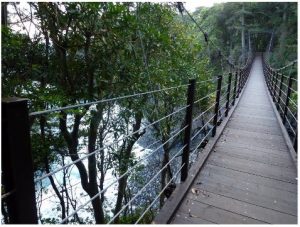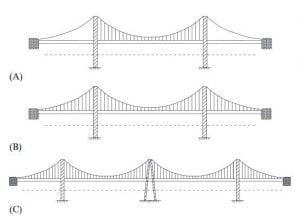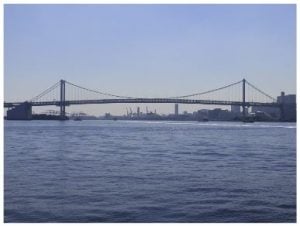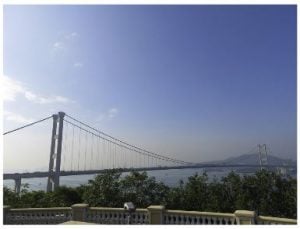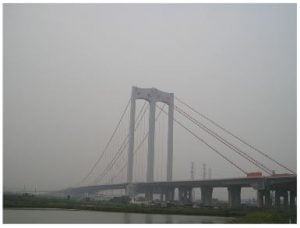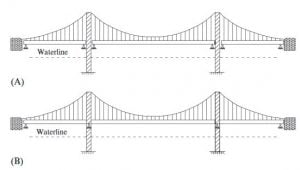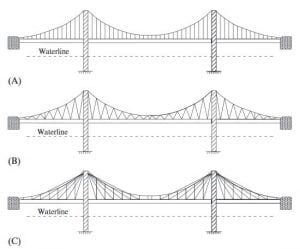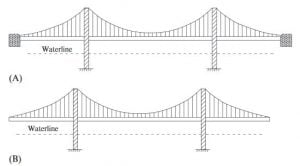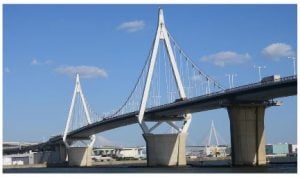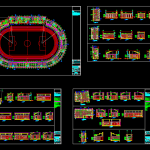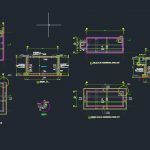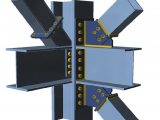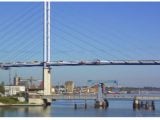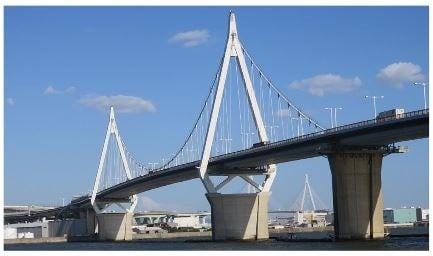
Suspension Bridge Classification
29 January 2020Table of Contents
Suspension Bridge Classification
In general, the suspension bridges can be classified according to theirspan numbers, the connection between stiffener girders, the layout of sus-penders, and anchoring conditions, etc.
1. According to Span Numbers
Based on the number of spans and towers, there are single-span, two-span,or three-span suspension bridges, as shown in Fig. 2. Among them,three-span suspension bridges with two main towers are the most commonlyused in engineering practice, like the Rainbow Bridge in Tokyo as shown in Fig. 3.
Fig.1 A suspension bridge in Izu, Japan
Fig.2. Suspension bridge classification according to span numbers. A) Single span.(B) Three-span. (C) Four (or multi) -span.
The Tsing Ma Bridge in Hong Kong and the Pingsheng Bridge in Guangdong are typical single-span suspension bridges, as shown in Figs. 4 and 5.
For multispan suspension bridges with more than two towers, the horizontal displacement of the tower tops due to live loads can be a concern and measures for controlling such displacement becomes necessary.
The Tamate Bridge built in 1928 in Japan is a typical multispan suspensionbridge, which is still in use now. Since then, several bridges were built inFrance (Pont de Château neuf-sur-Loire, 1932; Chatillon Bridge, 1951; and Bonny-sur-Loire Bridge, etc.), Switzerland (Giumaglio Footbridge).
Fig.3. The Rainbow Bridge, Tokyo
Fig.4. The Tsing Ma Bridge in Hong Kong
Fig.5. The Pingsheng Bridge Guangdong, China
Mozambique (Samora Machel Bridge, 1973), and Nepal (Dhodhara-Chandani Suspension Bridges, 2005). These bridges are generally built ina relatively short span except the Taizhou Yangtze River Bridge in China, which has three main towers and two main spans with a span length of1080 m, currently are the largest such suspension bridges.
2. According to Stiffening Girders
Based on the continuity, there are two types of stiffening girders, namelytwo-hinge or continuous types, as shown in Fig.6. Two hinge stiffening girders are commonly used for highway bridges, while the continuous stiffening girder is often used for combined highway-railway bridges to ensure the continuity between adjacent spans and to secure the smooth operation of the trains (Alampalli and Moreau, 2015).
The Akashi Kaikyo Bridge, the longest suspension bridge in the world, was designed with atwo hinged stiffening girder system.
Fig.6. Suspension bridge classification according to stiffener girders. (A) Two hinged stiffening girder. (B) Continuous stiffening girder.
3. According to Suspenders
In suspension bridges, suspenders (or hangers) can be designed as either ver-tical or diagonal, as shown in Fig.7. Vertical suspenders are more oftenused in suspension bridges, but diagonal hangers are sometimes used for the sake of increasing the damping and improving the seismic performance ofsuch bridges. For higher stiffness of a cable supported bridge, a combinedsuspension and cable-stayed cable system can also be used.
Fig.7. Suspension bridge classification according to suspenders. (A) Vertical sus-penders. (B) Inclined suspenders.
4. According to Anchoring Conditions
Based on anchoring conditions, the suspension bridges can be classified intoexternally anchored or self-anchored types, as shown in Fig.8. For externally anchored suspension bridges, the anchorages need to be built on both ends ofthe bridges to sustain the tensile forces from the main cable, which is the mostcommon type of suspension bridges.
As for self-anchored suspension bridges,the anchorages are not necessary and main cables are connected directly to thestiffening girders. In this case, however, relatively large axial compressiveforces need to be carried by the main girder and this should be consideredin the design. The San Francisco Oakland Bay Bridge and Konohana Bridgein Osaka (Fig.9) are typical self-anchored suspension bridges.
Fig.8. Suspension bridge classification according to anchors. (A) Externallyanchored suspension bridges. (B) Self anchored suspension bridges.
Fig.9. The Konohana Bridge (self-anchored suspension bridge) in Osaka, Japan.

